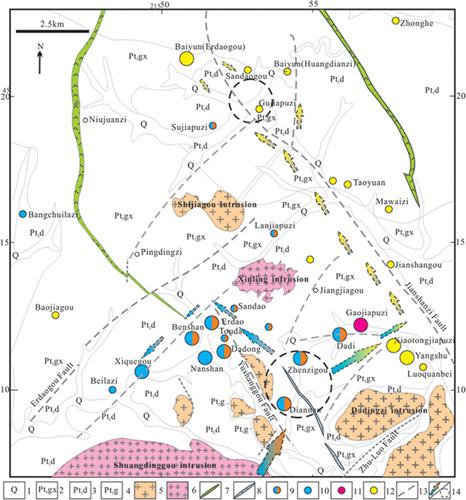当前位置:
X-MOL 学术
›
Resour. Geol.
›
论文详情
Our official English website, www.x-mol.net, welcomes your feedback! (Note: you will need to create a separate account there.)
Iron isotopes as an ore-fluid tracer: Case study of Qingchengzi Pb-Zn-Au(-Ag) orefield in Liaoning, NE China
Resource Geology ( IF 1.4 ) Pub Date : 2021-06-17 , DOI: 10.1111/rge.12261 Dedong Li 1 , Yuwang Wang 1 , Jingbin Wang 1 , Chunkit Lai 2 , Jinzhu Qiu 3 , Wei Wang 3 , Shenghui Li 3 , Zhichao Zhang 1
Resource Geology ( IF 1.4 ) Pub Date : 2021-06-17 , DOI: 10.1111/rge.12261 Dedong Li 1 , Yuwang Wang 1 , Jingbin Wang 1 , Chunkit Lai 2 , Jinzhu Qiu 3 , Wei Wang 3 , Shenghui Li 3 , Zhichao Zhang 1
Affiliation

|
The Qingchengzi Pb-Zn-Au (-Ag) orefield (eastern Liaoning province, NE China) is located in the northeastern margin of the North China Craton. The unconventional Fe isotopes of pyrites were analyzed to unravel the ore-material source and migration pathway of the ore fluids. Pyrite samples of ores and wallrocks from various deposits in the orefield were collected and the solutions were analyzed by MC-ICP-MS. The results show that most pyrite samples contain heavier Fe isotopes than the international pyrite standard IRMM-014. Within a particular deposit, Fe isotopes become lighter with depth. For example, the pyrite δ56Fe values drop from 0.216 ~ 0.408‰ (150-m level) to −0.284 to −0.132‰ (210-m level) at the Zhenzigou deposit. Gold deposits in the orefield also have similar features: At Baiyun (Huangdianzi), the pyrite δ56Fe values (0.394 ~ 0.627‰) of the silicic-/potassic-altered rock-type ore (130-m level) are significantly higher than that (0.359‰) of the quartz vein-type ore (440-m level). The lamprophyre δ56Fe values from different deposits are largely similar (0.040 ~ 0.024‰), whereas those in the wallrocks vary considerably (0.144 ~ 1.238‰). Compiling the pyrite δ56Fe values from many important sedimentary/metamorphic rock units in the region and magmatic-hydrothermal deposits around the world, we concluded that the Qingchengzi Pb-Zn-Au(-Ag) deposits belong to intrusion-related magmatic-hydrothermal type. The spatial fluid isotope variation pattern, and the fact that early-formed sulfides have lighter isotopes than later ones, suggest that the Qingchengzi ore fluids may have originated from Zhenzigou-Diannan (hydrothermal center) and outflown to Xiaotongjiapuzi, Gujiapuzi-Baiyun and Erdao-Xiquegou areas. The spatial fluid isotope variation pattern also suggests another possible hydrothermal center at Baiyun-Gujiapuzi. The ability to identify hydrothermal center(s) and delineate fluid migration pathways suggests that pyrite Fe isotopes can serve as a tool for precious and base metals prospecting.
更新日期:2021-06-17



























 京公网安备 11010802027423号
京公网安备 11010802027423号